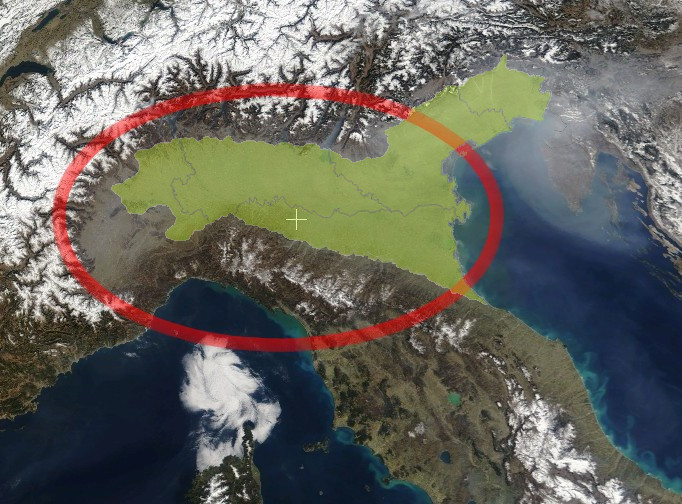|
Culatello Di Zibello
''Culatello di Zibello'' is a cured meat with a protected designation of origin (PDO) in the EU and UK typical of the province of Parma. Listed among the Slow Food Presidia of Emilia-Romagna, ''culatello'', mentioned for the first time in a document dating back to 1735, is produced from the leg of pork, which is then stuffed into the pig's bladder. Production The Consortium of Culatello di Zibello has established that the processing of ''culatello di Zibello'' can take place only in a limited, specified area and only from October through February, when ''la bassa'' is enveloped in cold fog. It is then that the part of meat obtained from the thigh of adult pigs, bred according to traditional methods, is skinned, degreased, boned, separated from the '' fiocchetto'' and trimmed by hand, so as to give it its characteristic "pear" shape. The ''culatello'' and ''fiocchetto'' trimmings are then used in the preparation of ''strolghino ''Strolghino'' () is a ''salume'' prepared fro ... [...More Info...] [...Related Items...] OR: [Wikipedia] [Google] [Baidu] |
Italy
Italy, officially the Italian Republic, is a country in Southern Europe, Southern and Western Europe, Western Europe. It consists of Italian Peninsula, a peninsula that extends into the Mediterranean Sea, with the Alps on its northern land border, as well as List of islands of Italy, nearly 800 islands, notably Sicily and Sardinia. Italy shares land borders with France to the west; Switzerland and Austria to the north; Slovenia to the east; and the two enclaves of Vatican City and San Marino. It is the List of European countries by area, tenth-largest country in Europe by area, covering , and the third-most populous member state of the European Union, with nearly 59 million inhabitants. Italy's capital and List of cities in Italy, largest city is Rome; other major cities include Milan, Naples, Turin, Palermo, Bologna, Florence, Genoa, and Venice. The history of Italy goes back to numerous List of ancient peoples of Italy, Italic peoples—notably including the ancient Romans, ... [...More Info...] [...Related Items...] OR: [Wikipedia] [Google] [Baidu] |
Emilia-Romagna
Emilia-Romagna (, , both , ; or ; ) is an Regions of Italy, administrative region of northern Italy, comprising the historical regions of Emilia (region), Emilia and Romagna. Its capital is Bologna. It has an area of , and a population of 4.4 million. Emilia-Romagna is one of the wealthiest and most developed regions in Europe, with the third highest gross domestic product per capita in Italy. It is also a cultural center, being the home of the University of Bologna, the oldest university in the world. Some of its cities, such as Modena, Parma, Ferrara, and Ravenna, are UNESCO heritage sites. It is a center for food and automobile production (such as Ferrari, Lamborghini, and Maserati). It has coastal resorts such as Cervia, Cesenatico, and Rimini. In 2018, the Lonely Planet guide named Emilia-Romagna as the best place to see in Europe. Etymology The name ''Emilia-Romagna'' is a legacy of Ancient Rome. ''Emilia'' derives from the ''via Aemilia'', the Roman road connecting Pia ... [...More Info...] [...Related Items...] OR: [Wikipedia] [Google] [Baidu] |
Curing (food Preservation)
Curing is any of various food preservation and flavoring processes of foods such as meat, fish and vegetables, by the addition of salt, with the aim of drawing moisture out of the food by the process of osmosis. Because curing increases the solute concentration in the food and hence decreases its water potential, the food becomes inhospitable for the microbe growth that causes food spoilage. Curing can be traced back to antiquity, and was the primary method of preserving meat and fish until the late 19th century. Dehydration was the earliest form of food curing. Many curing processes also involve smoking, spicing, cooking, or the addition of combinations of sugar, nitrate, and nitrite. Meat preservation in general (of meat from livestock, game, and poultry) comprises the set of all treatment processes for preserving the properties, taste, texture, and color of raw, partially cooked, or cooked meats while keeping them edible and safe to consume. Curing has been the dominant m ... [...More Info...] [...Related Items...] OR: [Wikipedia] [Google] [Baidu] |
Protected Designation Of Origin
The protected designation of origin (PDO) is a type of geographical indication of the European Union aimed at preserving the designations of origin of food-related products. The designation was created in 1992 and its main purpose is to designate products that have been produced, processed and developed in a specific geographical area, using the recognized know-how of local producers and ingredients from the region concerned. Features The characteristics of the products protected are essentially linked to their terroir. The European or UK PDO logo, of which the use is compulsory, documents this link. European Regulation 510/2006 of 20 March 2006 acknowledges a priority to establish a community protection system that ensures equal conditions of competition between producers. This European Regulation is intended to guarantee the reputation of regional products, adapt existing national protections to make them comply with the requirements of the World Trade Organization, and info ... [...More Info...] [...Related Items...] OR: [Wikipedia] [Google] [Baidu] |
Province Of Parma
The province of Parma () is a Provinces of Italy, province in the Emilia-Romagna region of Italy. Its largest town and capital is the city of Parma. It is made up of 47 ''comuni'' (: ''comune''). It has an area of and a total population of around 450,000. The province is bordered by the province of Reggio Emilia to the east, the Province of Piacenza, Piacenza to the west, Lombardy's provinces of Province of Cremona, Cremona and Province of Mantua, Mantua to the north and by Liguria's provinces of Province of La Spezia, La Spezia and Province of Genoa, Genoa and Tuscany's Province of Massa-Carrara to the south. History In 1861, Provinces of Italy, Italian provinces were established on the French republican model. Italian Fascism saw the end of elections in the province of Parma in the 1920s until the end of the Second World War. Geography The province is divided into three zones from north to south: the ''pianura'' (plains), the ''collina'' (hills) and the ''montagna'' (mo ... [...More Info...] [...Related Items...] OR: [Wikipedia] [Google] [Baidu] |
Pig Bladder
A pig bladder or pig's bladder is the urinary bladder of a domestic pig, similar to the human urinary bladder. Today, this hollow organ has various applications in medicine, and in traditional cuisines and customs. Historically, the pig bladder had several additional uses, all based on its properties as a lightweight, stretchable container that could be filled and tied off. Traditional uses The pig bladder has several traditional ceremonial uses in Europe. It is traditional during the festival Fasching in Bad Aussee to brandish inflated pig bladders on sticks. Similarly, in Xinzo de Limia, Spain, inflated pig bladders are carried during Carnival. See also Clown society and Jester and Gigantes y cabezudos and Vejigante. In traditional Germanic communities a public Schlachtfest (of a pig) is announced by hanging the pig's inflated bladder in front of the host establishment. The bladder is used as a casing for several traditional food items, including the sausages known ... [...More Info...] [...Related Items...] OR: [Wikipedia] [Google] [Baidu] |
Zibello
Santi Gervasio e Protasio Zibello is a town in the Province of Parma in the Italian region Emilia-Romagna, located about northwest of Bologna and about northwest of Parma. It was an independent ''comune'' until 1 January 2016, when it merged with Polesine Parmense to form the new ''comune'' of Polesine Zibello. The town is also known for the production of culatello di Zibello ''Culatello di Zibello'' is a cured meat with a protected designation of origin (PDO) in the EU and UK typical of the province of Parma. Listed among the Slow Food Presidia of Emilia-Romagna, ''culatello'', mentioned for the first time in a do .... Cities and towns in Emilia-Romagna {{EmiliaRomagna-geo-stub ... [...More Info...] [...Related Items...] OR: [Wikipedia] [Google] [Baidu] |
Po Valley
The Po Valley, Po Plain, Plain of the Po, or Padan Plain (, , or ) is a major geographical feature of northern Italy. It extends approximately in an east-west direction, with an area of including its Venetian Plain, Venetic extension not actually related to the Po (river), Po basin; it runs from the Western Alps to the Adriatic Sea. The flatlands of Veneto and Friuli are often considered apart since they do not drain into the Po, but they effectively combine into an unbroken plain, making it the largest in Southern Europe. It has a population of 17 million, or a third of Italy's total population. The plain is the surface of an in-filled system of ancient canyons (the "Apennine Foredeep") extending from the Apennine Mountains, Apennines in the south to the Alps in the north, including the northern Adriatic. In addition to the Po and its affluents, the contemporary surface may be considered to include the Savio (river), Savio, Lamone (river), Lamone and Reno (river), Reno to the ... [...More Info...] [...Related Items...] OR: [Wikipedia] [Google] [Baidu] |
Strolghino
''Strolghino'' () is a ''salume'' prepared from pork. It is thin, with an average weight of 300 grams, and may be prepared from the "lean leg meat" of the domestic pig. Leftover cuts of meat from the preparation of '' culatello'' are typically used. It may be prepared from parts of the pig that are not used in ham. ''Strolghino'' may only be available for only a few months in some areas. It may have a relatively short curing time of 15–20 days, which results in a very tender product resembling "fresh, raw sausage meat". The word derives from the word ''strolga'', which in the Emilian dialect means 'witch' or 'soothsayer'/'fortune-teller', as it was believed that they could be used as an early predictor of the quality of the ''culatello''—which requires a much longer curing time—from which the meat used to make the ''strolghino'' was trimmed. In the Italian cities of Cremona and Parma, it may be referred to as "''salame strolghino''", and its preparation in these areas ... [...More Info...] [...Related Items...] OR: [Wikipedia] [Google] [Baidu] |
Prosciutto
Prosciutto ( ; ), also known as ''prosciutto crudo'', is an uncooked, unsmoked, and dry-cured ham. It is usually served thinly sliced. Several regions in Italy have their own variations of ''prosciutto crudo'', each with degrees of protected status, but the most prized are ''Prosciutto di Parma'' DOP, from Emilia-Romagna, and ''Prosciutto di San Daniele'' DOP, from Friuli-Venezia Giulia. Unlike speck ( Speck Alto Adige) from the South Tyrol region, prosciutto is not smoked. There is also a tradition of making prosciutto in southern Switzerland. In Italian, ''prosciutto'' means any type of ham, either dry-cured (''prosciutto crudo'' or simply ''crudo'') or cooked (''prosciutto cotto''), but in English-speaking countries, it usually means either Italian ''prosciutto crudo'' or similar hams made elsewhere. However, the word ''prosciutto'' itself is not protected; cooked ham may legally be, and in practice is, sold as ''prosciutto'' (usually as ''prosciutto cotto'', and from I ... [...More Info...] [...Related Items...] OR: [Wikipedia] [Google] [Baidu] |
Italian Cuisine
Italian cuisine is a Mediterranean cuisine#CITEREFDavid1988, David 1988, Introduction, pp. 101–103 consisting of the ingredients, recipes, and cooking techniques developed in Italy since Ancient Roman cuisine, Roman times, and later spread around the world together with waves of Italian diaspora. Significant changes Columbian exchange, occurred with the colonization of the Americas and the consequent introduction of potatoes, tomatoes, capsicums, and maize, as well as sugar beet—the latter introduced in quantity in the 18th century. It is one of the best-known and most widely appreciated Gastronomy, gastronomies worldwide. Italian cuisine includes deeply rooted traditions common throughout the country, as well as all the diverse Regional cuisine, regional gastronomies, different from each other, especially between Northern Italy, the north, Central Italy, the centre, and Southern Italy, the south of Italy, which are in continuous exchange. Many dishes that were once region ... [...More Info...] [...Related Items...] OR: [Wikipedia] [Google] [Baidu] |






